Launched in 1964, the first
generation Ford Mustang opened a new segment called "pony cars" which
would be hugely popular in the following decade and joined by Chevrolet
Camaro and Pontiac Firebird etc. The concept of pony cars was
originated by Lee Iacocca, general manager of Ford. Iacocca foresaw by
the mid-1960s the huge crowd of baby boomers (i.e. those born right
after the WWII) would get old enough to purchase their first cars. He
believed an inexpensive 2+2 sporting car would appeal most to these new
customers and generate huge sales. But unlike conventional cars, he
planned to offer plenty of choices of engines, transmissions,
performance and luxury equipment so that people could tailor make the
cars according to their needs and taste. For example, a college
graduate could choose a base car with straight-6 engine, 3-speed manual
gearbox and a bare interior for as little as US$2400, a young executive
could choose a convertible with V8 engine, automatic transmission,
fancy interior decorations and many luxurious equipment at double the
price, while a performance hunger could buy a high-output V8, 4-speed
manual box, limited slip differential, sports suspensions and tires at
extra costs. Pony cars could therefore attract different kinds of
customers and achieve huge volume. To push the price down, pony cars
would sacrifice sophisticated technology and use dedicated parts as few
as possible. Most components would be taken from the existing parts
pool to save costs.
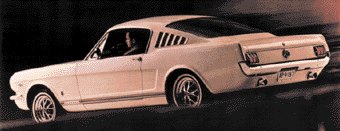 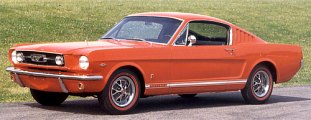 1965 Mustang fastback in the purest form
1965 Mustang fastback in the purest form
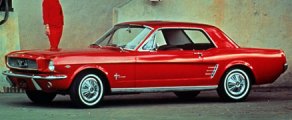 1967 Mustang hardtop
1967 Mustang hardtop
Part of its success
was down to the handsome styling, especially the original design running from 1964 to 1966
model year. Later cars would get only more makeup and more muscles to
deviate from its simple form. 3 body styles were offered: hardtop,
convertible and fastback, each had its own character. The fastback was
my favourite design, but the hardtop was by far the best selling model.
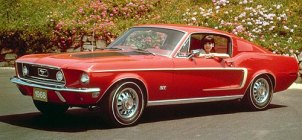 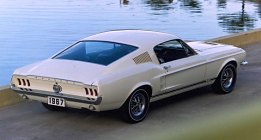 1967 Mustang fastback got longer and morre muscular, if no
more beautiful.
1967 Mustang fastback got longer and morre muscular, if no
more beautiful.
Mechanically, the Mustang was largely based on contemporary Falcon and
Fairlane sedan with conventional suspensions and FR drivetrain.
Measuring 4.6 meters long and 2.74 meters in wheelbase, American saw it
as a "compact car", although European would call it a large car
instead. 5 mass production engines were available: 101hp 2.8-liter
straight-6, 120hp 3.3-liter straight-6, 164hp 4.3-liter V8 and a pair
of 4.7-liter (289cid) V8 producing 210hp or 271hp with different
carburetors and tuning. Road test found the 271hp Mustang did 0-60 mph
in 8.2 seconds, excellent for its price, although a top speed of 116
mph had nothing to proud of.
Shelby
GT-350
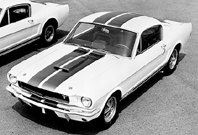 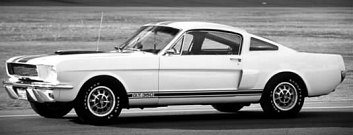
For promotional purpose, Ford
asked Carroll Shelby to develop a hotter Mustang to race in SCCA
Production class B. This resulted in GT-350R (the race car) and GT-350
(the road car built for homologation). Close to 3000 road cars were
produced in two years.
The GT-350 was more powerful yet lighter than the regular Mustang.
Based on the high-output 289 engine, it received the same tuning as the
road-going GT40 supercar to release another 35 horsepower. Then the
chassis was reinforced by adding a tower bar across the front
suspension pickup points, the suspensions got thicker anti-roll bars
and Koni adjustable shock absorbers, the front drum brakes were
replaced with disc brakes, the steering got quicker ratio, the new
gearbox employed aluminum case, the rear seat was ditched and the hood
was converted to fiberglass to save weight. As a result, both
performance and handling were greatly improved. Thanks to the work of
Shelby, Mustang finally became a really sporty car !
The race car GT-350R was equally successful by winning the SCCA
production car championship three times in a row from 1965 to 1967.
Entering musclecar era, a
horsepower race became inevitable. From 1967, Shelby produced an even
more powerful GT500 with 428cu (or 7.0 liters) big block V8. This
engine was rated conservatively at 355 horses to cheat insurance
companies. In fact, the real output should be closer to 400hp, gross
power of course. Unfortunately, the luxurious-biased GT500 was a lot
heavier than GT-350, cancelling most of the power gain. Moreover, its
heavyweight engine put an extra 80 kg over the front axle, resulted in
poorer balance and worse handling. Therefore keen drivers still
prefered the lighter and more agile GT-350.
|